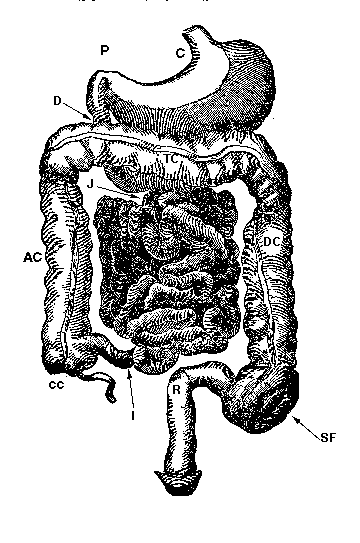
THE ENEMA
DESCRIPTION
OF' THE STOMACH AND INTESTINES:
THE FALLACY OF "PURGATIVES":
THE PRINCIPLES AND USE OF THE EDEMA:
NOTES ON GIVING THE ENEMA TO CHILDREN
AND ON AN ENEMA TACTIC
THE ACCOMPANYING diagram of the human stomach and intestines is essential to a proper understanding of the digestive and eliminative functions of the body. It should be carefully studied in connection with the following description of the organs displayed.

"P. C.".--The Stomach.
This organ is a pear-shaped muscular bag, which receives the food after it has been masticated in the mouth. In mastication food is moistened and softened by the saliva, which also acts chemically upon certain elements, notably starch. Masticated food reaches the stomach through its upper or cardiac opening by means of a tube called the esophagus. Gastric juice, the normal secretion of the stomach, then begins its work of further transformation. While stomach digestion is proceeding, the liquid portion of the mass and the fluids drunk are in great part separated from the solids, and are at once absorbed into the circulation. The residue, called chyme, then passes through the lower or pylorio opening of the stomach into the small intestine.
"D. J. I."--The Small Intestine.
This portion of the digestive apparatus consists of a long tube, varying between twenty and thirty feet in length, which is ingeniously coiled upon itself. It is lined with what appears to be a soft velvety covering, an appearance that is caused by numerous minute elevations, the villi, which act as absorbents and secretents. In the upper part of the small intestine, chyme is subjected to the action of bile, the secretion of the liver, and to that of the pancreatic juice, the secretion of the pancreas, as well as to that of the secretion of the walls of the intestine itself. All of these juices still further soften and dissolve the food mass, and chemically transform the chyme into substances that permit of absorption through the villi into the blood. After the tissue-building portion is absorbed, the remainder--the refuse matter, the excrement--passes through a small opening known as the ileo-cecal valve into the large intestine or colon. This valve is constructed in such manner as to permit the waste to pass freely into the colon, but it prevents any backward movement or return to the small intestine.
"CC."--The Cecum.
The cecum is the large end of the colon situated just beyond the point at which the waste enters from the small intestine.
Home | Contact Us | Site Map
© COPYRIGHT 2003 ALL RIGHTS RESERVED http://www.scientificfasting.com